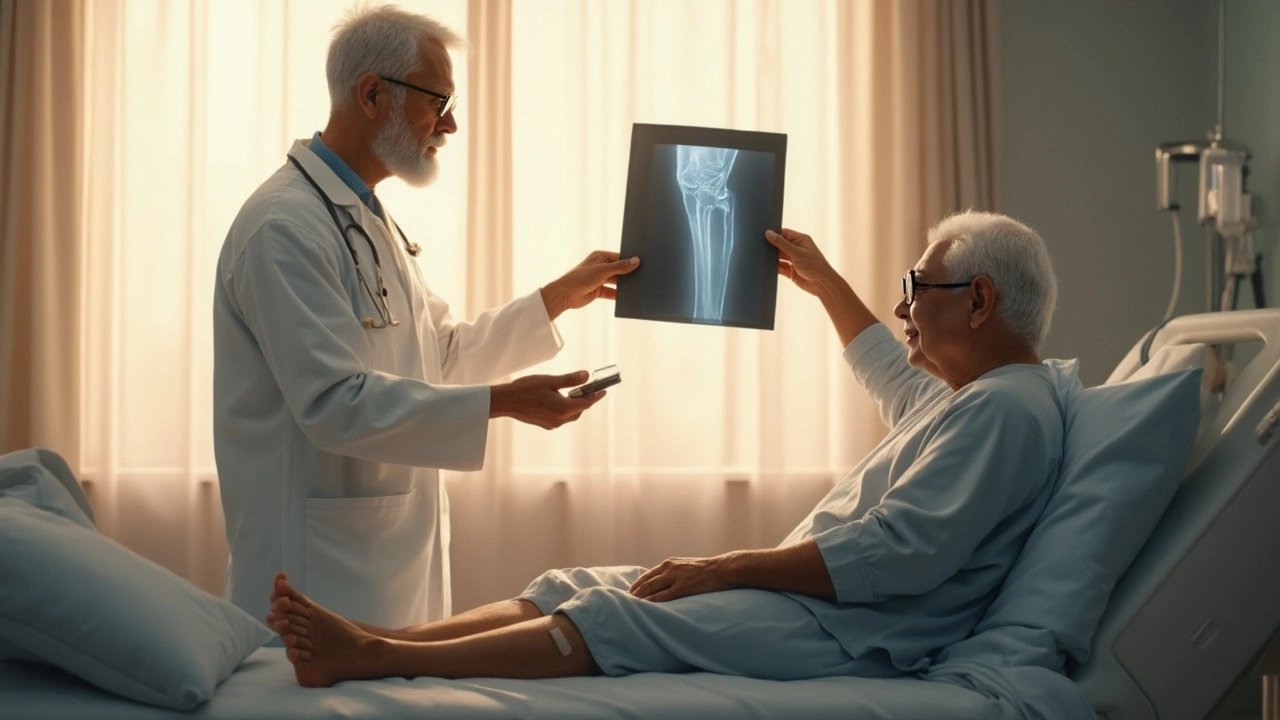
- Feb, 17 2025
- 0
So, you've had a total knee replacement—congratulations on taking that step toward better mobility! But as much as we'd like the journey to end there, recovery comes with its own set of challenges. It's important to keep an eye out for certain red flags during this time. Recognizing these early can be the difference between a smooth recovery and facing complications. So, what are these warning signs? Let's chat about them.
First off, pain is expected, but unusual or persistent pain isn't. If you find yourself wincing more than expected or the pain is simply not letting up, it might be time to pay attention. Sure, discomfort is part of the deal, but you know your pain threshold and when something feels off.
- Recognizing Unusual Pain
- Swelling and Redness
- Changes in Mobility
- Signs of Infection
- Fever and Chills
- When to Call Your Doctor
Recognizing Unusual Pain
After a knee replacement, some degree of pain is normal—really, it's an expected part of healing. But how do you know if the pain you're experiencing is beyond the ordinary? Let's break it down.
Typically, the pain should gradually decrease each week. If you notice an increase in intensity or duration, it can be a red flag. When sharp, stabbing pain suddenly appears during an activity or even while resting, it’s a signal you shouldn’t ignore.
Regular Healing vs. Problematic Pain
In the first few weeks, it’s common to feel discomfort as your body adjusts. However, if your pain feels severe, hinders sleep, or worsens over time instead of improving, it warrants a closer look.
- Sharp or shooting pains: These can indicate nerve issues or even a dislocated knee cap. These are uncommon but important to address immediately.
- Pain accompanied by swelling: While some swelling is normal, when it pairs with increased pain, it might suggest an infection.
Personal Pain Threshold
Everyone’s pain threshold is different, and you know yours best. If you're suddenly experiencing a throbbing or burning sensation that feels off, don't hesitate to reach out to a healthcare professional.
A study published in 2023 found that about 10% of knee replacement patients experience chronic pain post-surgery. With swelling and unusual pain patterns being leading indicators of underlying issues, keeping an eye out for them can significantly improve recovery outcomes.
Remember, it's better to check in and find out everything is okay than to ignore a problem. Your body will thank you for it.
Swelling and Redness
Right after a knee replacement, it's quite normal to see some swelling and redness around your knee. But, there's a catch—this shouldn't get out of hand. The key is to know what's 'normal' swelling and when it starts waving a red flag.
Now, what might 'normal' look like? Generally, some initial swelling is expected for the first few weeks. Yet, if the swelling doesn't gradually decrease or suddenly worsens, it might be time to take a closer look.
When Swelling and Redness Go South
So, when should you get worried? If swelling is accompanied by intense redness or if it feels warm to the touch, this can signal inflammation or even infection. And that's when you don't play the waiting game. It's best to check in with your healthcare provider sooner rather than later.
In serious cases, one might experience excessive fluid buildup, known as joint effusion. This often causes the knee to feel tight and can even restrict your range of motion, making it difficult to perform daily activities.
Keep an Eye on These Signs
- Swelling that doesn't go down with ice or elevation.
- Sudden increase in size or tightness in your knee.
- Intense redness or shiny skin around the joint.
- Skin that's hot to the touch over the operated knee.
Spotting these signs early can help manage potential complications. Keeping up with your follow-up appointments and describing any changes you're noticing during recovery is key. By staying vigilant, you'll be paving the way for a smoother healing journey.
Changes in Mobility
Alright, let's talk about how your mobility should look post-surgery. After a total knee replacement, everyone's goal is to move more easily and with less pain. But sometimes, things don't go as planned. If your movement feels restricted or if you're suddenly struggling to do things that were becoming easier, that's a signal you should pay attention to.
In the early days following surgery, you might use a walker or crutches. That's normal. But over time, these aids should be needed less and less. If you find yourself relying on them more, or if you're unable to bend or straighten your knee like you used to, it could mean there’s a problem.
Stiffness and Unusual Struggles
Experiencing increased stiffness or difficulty in bending the knee isn't uncommon, but it shouldn’t get worse. Some folks experience a sensation known as 'knee catching' where it feels like the joint is locking. While occasional cracking or popping sounds can be harmless, a stuck sensation isn't usual and should get checked out.
Rehabilitation Progress
Your recovery plan might involve physical therapy to help gain strength and improve joint flexibility. Slower progress can happen, but if you're backsliding or stuck on the same physical therapy exercises, it's time to alert your healthcare provider.
In some cases, there might be legitimate reasons for these changes. According to the Journal of Bone and Joint Surgery, nearly 10% of patients face extended recovery timelines due to unforeseen complications. But identifying red flags early on can help tackle these issues head-on.
When to Act
If any change in your mobility makes you uncomfortable or you're battling more unstable movement, it's crucial to contact your doctor. Early intervention can mean the difference between a minor irritation and a major problem.

Signs of Infection
Recognizing the signs of infection after a knee replacement surgery can save you a world of trouble. Infection is one of those things that, if caught early, can often be dealt with effectively. So, what should you be looking out for?
Redness and Swelling
A little redness and swelling might be normal, But if you notice these symptoms getting worse or if they persistently hang around longer than expected, it might be a sign of infection.
Warmth and Tenderness
If your knee feels warm to touch—even more so than usual—and is tender, don't downplay it. This warmth could mean that there's an infection bubbling under the surface.
Discharge
Check for any discharge or fluid oozing from your surgical site. If there is, especially if it's cloudy or has a foul odor, it could be a clear indication of infection. In such cases, seeking medical attention is vital.
Fever and Chills
If you suddenly develop a fever or chills, it might be your body signaling a problem. Though not everyone with a post-surgery infection will run a fever, it's a common symptom that shouldn't be ignored.
Feeling Unwell
This one is more general, but a sense of overall malaise or feeling unwell without a clear reason could be telling you something isn't right. Trust your gut—if you feel off, get it checked out.
It’s worth noting that infections after knee replacement are rare but not impossible. From my conversations with healthcare professionals, they emphasize acting fast when something seems off. So, pay attention to your body's signals and don't hesitate to call your doctor if things don't feel right.
| Signs | Action |
|---|---|
| Persistent redness | Consult your doctor |
| Oozing discharge | Urgently seek medical attention |
| Persistent fever | Contact healthcare provider |
Fever and Chills
After a knee replacement, keeping an eye on your body’s temperature is a good idea. A mild increase in body temperature can be normal right after surgery. However, if you experience fever and chills a few days or weeks later, it could be a warning sign of something more serious, like an infection.
Infections after a knee replacement are not common but can happen. Infections may cause your body to react with a fever as it tries to fight off bacteria or viruses. In addition, chills often accompany a fever, making you feel shaky or cold.
When Is a Fever a Concern?
If your temperature goes above 100.4°F (38°C), that's when you should start being vigilant. Consistently high fevers, especially paired with chills, should prompt you to get in touch with your doctor. They might run some tests to ensure everything is okay.
Other Symptoms to Watch With Fever
A fever might not come alone. Look for other symptoms like:
- Redness or warmth around the knee
- Increased pain when moving the joint
- Pus or discharge from the incision site
These could further signal an infection needing immediate medical attention.
Preventing Infection
While it’s crucial to know the signs of infection, prevention is just as important. Keeping your incision clean and dry is a must. Also, follow your doctor’s advice on wound care and any antibiotics they prescribe. If you ever doubt your status post-surgery, err on the side of caution and consult with your healthcare provider.
When to Call Your Doctor
Knowing when to call your doctor after a knee replacement isn't always straightforward. You don't want to stress over every little ache, but there are certain signals you shouldn't ignore. Here's the scoop on when to pick up that phone.
Unmanageable Pain
If the pain has escalated to the point where it's disrupting your daily life and over-the-counter medications aren't cutting it, reach out to your healthcare provider. Persistent pain can indicate issues like loosening of the implant or even a fracture.
Swelling and Redness
While some swelling is expected, sudden increase or redness around the knee might be signs of infection. If it’s accompanied by warmth or tenderness, time to get it checked.
Signs of Infection
- Warmth and redness around the incision.
- Pus or drainage from the wound.
- Persistent fever over 100.4°F (38°C).
The longer these symptoms persist, the more crucial it is to contact your doctor.
Mobility Changes
Notice yourself losing range of motion or feeling stiffness that won't go away? It may not just be post-surgery stiffness. Early detection of mobility issues can prevent further complications.
Fever and Chills
Feeling feverish or having repeated chills can indicate a systemic infection. Combined with other red flags like swelling or drainage, this requires immediate medical attention.
Your doctor can provide solutions ranging from antibiotics to more intensive interventions, depending on what's going on. Trust your instincts; after all, nobody knows your body better than you do.
If these signs are happening, it's better to be safe than sorry. Quick action is your strongest ally in making sure your recovery stays on track.
Nikhil Verma
I'm a dedicated physician with a passion for exploring the intricacies of medicine, focusing on the unique healthcare challenges in India. I spend much of my spare time writing articles aimed at improving public understanding of health issues. Balancing my clinical practice and writing allows me to reach a wider audience, sharing insights and fostering a deeper appreciation for medical advancements. I derive immense satisfaction from both treating patients and engaging with readers through my writing.